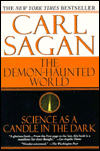
Demon-Haunted World: Science as a Candle in the Dark
Carl Sagan
Click here for other titles by
Carl Sagan
Want to comment? Visit our publications message board,
ISBN: 0345409469
Publisher: Ballantine Books, Inc.
Pub. Date: March 1997
Edition Desc: REPRINT
Are we on the brink of a new Dark Age of irrationality and superstition? In this stirring, brilliantly argued book, internationally respected scientist Carl Sagan shows how scientific thinking is necessary to safeguard our democratic institutions and our technical civilization. The Demon-Haunted World is more personal and richer in moving and revealing human stories than anything Sagan has previously written. With illustrations from his own childhood experience as well as engrossing tales of discovery, Sagan shows how the method of scientific thought can cut through prejudice and hysteria to uncover the often surprising truth. He convincingly debunks "alien abduction," "channelers," faith-healer fraud, the "face" on Mars, and much else. Along the way , he refutes the arguments that science destroys spirituality or is just another arbitrary belief system, asks why scientific study is often stigmatized, discusses the dangers of the misuse of science, and provides a "baloney detection kit" for thinking through political, social, religious, and other issues.
From Scientific American:
Books promoting pseudoscience are often popular and profitable--James Redfield's The Celestine Prophecy has sat on the best-seller list for more than two years. Skeptical books are much less marketable and so are comparatively rare. Rarer still are those of the caliber of Carl Sagan's new work, which joins a small but distinguished group that includes such classics as Charles Mackay's Extraordinary Popular Delusions and the Madness of Crowds (published in 1843) and Martin Gardner's Fads and Fallacies in the Name of Science (1957).
From Publisher's Weekly:
Eminent Cornell astronomer and bestselling author Sagan debunks the paranormal and the unexplained in a study that will reassure hardcore skeptics but may leave others unsatisfied. To him, purported UFO encounters and alien abductions are products of gullibility, hallucination, misidentification, hoax and therapists' pressure; some alleged encounters, he suggests, may screen memories of sexual abuse. He labels as hoaxes the crop circles, complex pictograms that appear in southern England's wheat and barley fields, and he dismisses as a natural formation the Sphinx-like humanoid face incised on a mesa on Mars, first photographed by a Viking orbiter spacecraft in 1976 and considered by some scientists to be the engineered artifact of an alien civilization. In a passionate plea for scientific literacy, Sagan deftly debunks the myth of Atlantis, Filipino psychic surgeons and mediums such as J.Z. Knight, who claims to be in touch with a 35,000-year-old entity called Ramtha. He also brands as superstition ghosts, angels, fairies, demons, astrology, Bigfoot, the Loch Ness monster and religious apparitions. (Feb.)